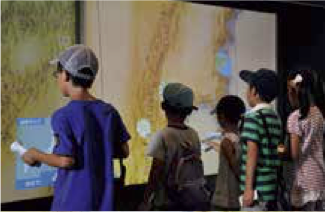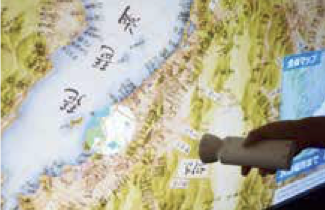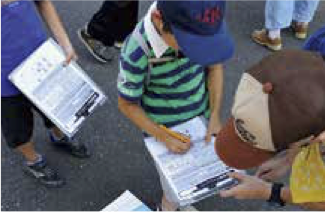New, Engaging Experience of Viewing Cultural Assets
Toppan Printing and KMD “Interactive Museum”
KMD Associate Professor Kouta Minamizawa led a team of students working on “the creation of novel viewing experience at museums,” a Real Project with Toppan Printing. Their goal was to create interactive experiences to allow visitors to more actively engage with the exhibits. This co-research project investigated ways to use Toppan Printing’s VR (virtual reality) theater service that is offered at such cultural institutions as museums, to create “physical interaction designs.”
One of the results of the past two years of research was an event for elementary and junior-high school students held in conjunction with a VR experience called “Map of Japan created by Ino Tadataka“ that was shown in the summer of 2014 at the TNM & TOPPAN Museum Theater, co-produced by the Tokyo National Museum and Toppan Printing.
Koichi Yoshino, who researches VR at Toppan Printing’s Technical Research Institute, headed the project. “Our biggest achievement was to discover a new kind of viewing experience for visitors. For me, one of the big attractions of the Real Project was the environ- ment in which we worked. We shared the project task from the beginning, and then set about building a system based on find- ings from a user research,” he recalled.
The co-developed interactive installation used a flashlight-shaped controller that visitors could wave in front of the display to see a modern map superimposed on the “Map of Japan (Medim-sized map or Ino Chuzu),” an “Important Cultural Property.” The control- ler’s “magnifying glass-effect” allowed the visitor to enlarge the image. A number of people viewed the large screen installed in front of the Museum Theater while individual visitors wandered through the locations on the map that interested them. The inter- active installation was highly evaluated as it gave viewers a new and free perspective to experience the Ino Chuzu. It also helped to deepen their understanding of their VR experience in the Museum Theater and the actual artifacts on display in the Exhibit Hall.
Participants in the “Pacing Workshop,” which was held at the court- yard of the Tokyo National Museum in parallel to the Museum Theater exhibition, used 19th century surveying methods to create a simple map of Japan based on their own measurements. The synergy between the workshop and the VR presentation gave visi- tors a new and more realistic experience.
“I think we were successful because we were working in an actual museum and were able to prototype a number of ideas from the very first stages of the project. One of the things that set KMD Real Projects apart is that we actually turn our ideas into reality through technology in the course of joint research. In this case, we tried to find new ways to bring art and history to life, and create interactive installations that stimulate the creativity of younger viewers. We think there are broader applications to be explored,” says Associate Professor Minamizawa.
(This article was written in March 2015.)
The program at the TNM & Toppan Museum Theater featured two components: an interac- tive installation called “Magic Light on the Ino Map,” and in the courtyard, a workshop in which the participants experienced the technique of surveying through pacing titled “Survey the Tokyo National Museum, Just like Ino Tadataka!”
Graphical content from: Map of Japan (Medium -sized map or Ino Chuzu), By Ino Tadataka, Edo Period, 19th century, The TNM Collection (Important Cultural Property)



Koichi Yoshino of Toppan Printing’s Tech- nical Research Institute
